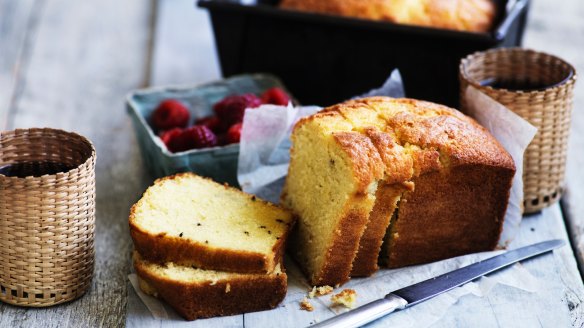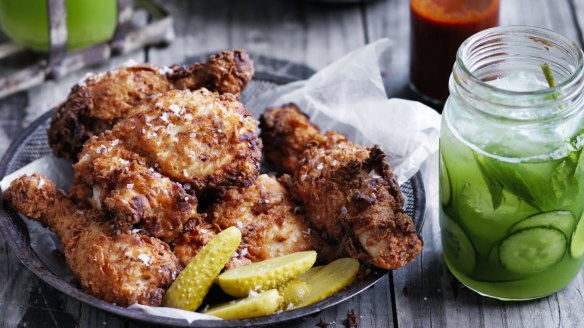Fergus Henderson on how to throw the perfect picnic

You may have heard of Fergus Henderson. He is the inimitable offal-loving chef and author behind St John Bread and Wine, the London institution where thousands have learnt the might and majesty of spreading bone marrow over toast while watching rain fall on the streets of Spitalfields.
To devotees of his books, Nose to Tail Eating and its sequel, Beyond Nose to Tail, Henderson is a deity resplendent in his rounded specs, pinstripe jackets and favourite pose: thumbs through lapels, chin up. David Chang and Mario Batali count him as an influence.
The self-taught chef, who trained to be an architect, put traditional British cooking and lesser cuts – the tripe; the chitterlings – under a spotlight that drew the attention of the world. Do you remember when nose-to-tail was the trend dominating every menu in the early thousands? It was Henderson who made it so.
To celebrate the start of outdoor eating season, we asked him to write an ode to picnics. Store it in your book of life.
Fergus Henderson's basket essentials
The first cry that goes out at a picnic is, "Where's the corkscrew?" Most of my picnics are in the Hebrides (remote islands off the Scottish mainland), which is robust landscape so we've collected a motley crew of nice plastic plates and glasses that will survive. I can't reiterate enough the call for a corkscrew! If you have champagne or white wine, make sure you've sourced a cool box. You also need sharp knives to slice things.
You need flavour in the outdoors, and steadying fare. Perhaps a small pot of Anchovy Gunge to dip boiled egg and raw veg in (to top up your five-a-day), a crusty bun with ham, salad and salad cream (cheeky – as this is one of the few moments that salad cream comes into its own). Then seed cake and madeira which is a good dish to keep coming back to during the course of the afternoon.
When it comes to perfect scenes in art or the memory, although Manet's Le Dejeuner sur l'Herbe comes to mind, the cold winds of the Hebrides lend themselves to more layers.
This applies to my greatest picnic memories as a child, in Tyree, leaping dangerously from rock to rock. Now no longer a child, there is no leaping but lots of wine and driftwood fires to cook lunch on. I've noted that I have rituals which may puzzle our guests sometimes but the great thing about picnics is, it's liberty hall.
A picnic needs order – someone needs to be head chef to make sure it all runs smoothly. If there are many young present, be sure to take many buns and sauces.
Now to the bottles: it's interesting how one's thirst grows in the outdoors. There are practical considerations: white wine does not work well as it never stays cold enough. [So], firstly a bottle of red, a not-too-heady pinot noir is perfect. Then a half bottle of madeira, not too sweet, and as a punctuation at the end you should have a miniature of brandy and a delicious bar of chocolate.
If this doesn't sound substantial enough, there are always oat cakes and sheep's milk cheese. Be happy, campers. One last thought, always remember a corkscrew!
Cured beef and celeriac
It's very important to have tasty food when outdoors. Cured beef and celeriac is easy to pinch with your fingers and also very flavoursome, both vital when in the open air. This curing process can also be used on a fillet of venison. If you don't eat it that day, it will be fine the next if kept in the fridge.
400g coarse sea salt
600g sugar
10 sprigs of rosemary
1 fillet of beef (ask your butcher to trim it)
a handful of finely cracked black pepper
1 head of celeriac, peeled
juice of 1 lemon
1 1/2 tbsp Dijon mustard
4 tbsp creme fraiche
sea salt and black pepper
1. Mix the salt and sugar together. Take a plastic container into which your fillet will fit uncured and which will fit in your fridge, and place five sprig of rosemary in the bottom.
2. Generously cover with the salt and sugar mix, lay the fillet on to this, then cover with the rest of the mix (if you have not got enough of the salt and sugar mixture, simply make up some more, 40 per cent salt to 60 per cent sugar). Nestle the rest of the rosemary into this. Cover the container and refrigerate for three days.
3. Remove the fillet from the now damp salt and sugar, rinse under cold running water, and dry with a clean cloth. When dry, take a handful of cracked pepper and rub the firm fillet all over; this should remove any remaining moisture and give an oomph to the meat. Wrap in cling film and keep in the fridge until you use it (this is not a long curing process and as a result the meat will not keep for more than a week and should be refrigerated).
4. Slice the celeriac very thinly, using the width of a match as a rough guide, then lay a manageable pile of slices flat and slice again into match widths. At this point a mandolin is very useful but if you don't have one, do not fear; you can easily achieve matchstick strips of celeriac with a knife. As you go, squeeze lemon juice over your growing mound of celeriac strands to prevent them going brown when finished. Fold the Dijon mustard and creme fraiche gently together – don't beat as the cream will lose its structure. Season to taste and mix this through the celeriac.
5. To serve the beef, slice thinly across. You will have beautiful dark red flesh – the colour of a fine old master comes to mind. The spirited wine celeriac makes a splendid accompaniment.
Serves 12

Seed cake and a glass of madeira
Eleven o'clock and still two hours until lunchtime. Something to keep you steady – nothing finer than a slice of seed cake, washed down by a glass of Madeira. This will see you safely through until lunch.
260g softened unsalted butter
260g castor sugar
1 tsp caraway seeds
5 large eggs, lightly beaten
320g self-raising flour
150ml full-fat milk
1. Grease a 16 x 10 x 8-centimetre loaf tin with butter and line the base and sides with baking parchment.
2. Cream the butter, sugar and caraways together either with an electric mixer or in a bowl with a wooden spoon until they are white and fluffy. Gradually mix in the beaten eggs, adding them little by little to prevent curdling. Then sift in the flour and mix until incorporated. Lastly add the milk.
3. Transfer the mixture to the prepared tin and bake in an oven preheated to 180C for 45 minutes or until it is golden brown and a skewer inserted in the centre comes out clean.
4. Serve with a glass of Madeira.
This is an edited extract from The Complete Nose to Tail by Fergus Henderson.

Pimp up your picnic
Cold-as cocktails
Remember Sunnyboys? You can buy coconut water in similar tetra-packs now. Smash one up to a slushie texture, whack in a sports drink mixer and shake with vodka or gin and lime for an instant frozen cocktail. Garnish with cucumber or more lime. Sweet-tooths can just use an original Sunnyboy too, or use Zooper Doopers cut with a little soda water.
Batch it up
Most of your favourite cocktails can be pre-matched and stored in water bottles for toting to the park. Think margaritas, negronis, Mojito or sangria (just avoid anything with a bubbly competent, or add that in later). Invest in an extra-large ice cube tray, so they won't melt as fast. Pop the cubes in zip lock bags, wrap in a wet tea towel and freeze the whole lot. Stash in a mini esky and assemble at will.
Booze-free
Make a simple sugar syrup with a twist: cut in lemon and wild thyme, grapefruit and rosemary or blueberries and cardamom. Let the whole lot simmer until infused and strain. Serve one part syrup to five parts soda with plenty of ice, or stir into a bottle with soda water before leaving the house.
Ad-hoc picnic gear
Low on Tupperware or don't want to cart it home to clean? Ask your local cafe for a few extra recyclable brown cardboard containers with your lunch order, or a couple of coffee cups with lids (these are great for chunky dips or storing small sweet and biscuits etc). They might charge you a gold coin or two, but they're handy to have.
SHARNEE RAWSON
The best recipes from Australia's leading chefs straight to your inbox.
Sign up